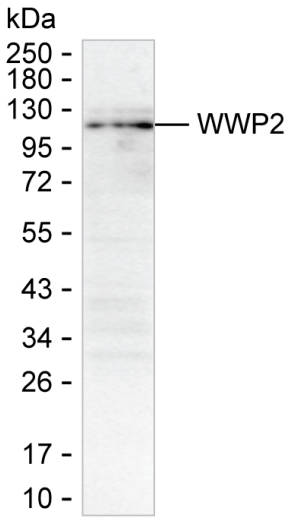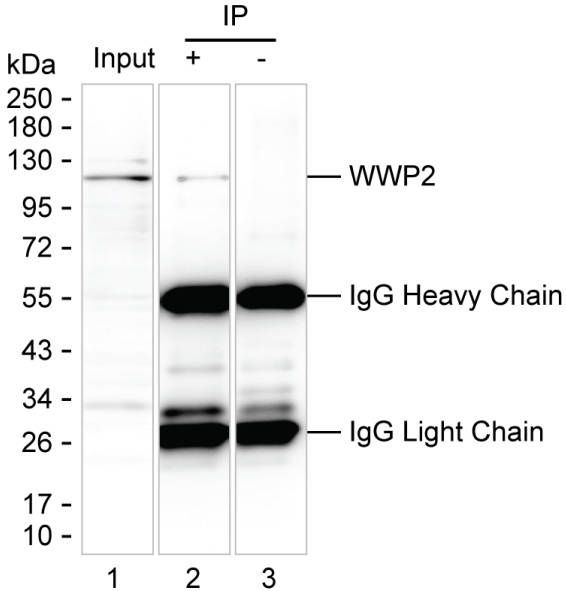

| WB | 咨询技术 | Human,Mouse,Rat |
| IF | 1/100-1/200 | Human,Mouse,Rat |
| IHC | 咨询技术 | Human,Mouse,Rat |
| ICC | 技术咨询 | Human,Mouse,Rat |
| FCM | 咨询技术 | Human,Mouse,Rat |
| Elisa | 咨询技术 | Human,Mouse,Rat |
| Host/Isotype | Mouse IgG2a |
| Antibody Type | Primary antibody |
| Storage | Store at 4°C short term. Aliquot and store at -20°C long term. Avoid freeze/thaw cycles. |
| Species Reactivity | Human |
| Immunogen | Purified recombinant fragment of human WWP2 |
| Formulation | Purified antibody in PBS with 0.05% sodium azide |
+ +
以下是关于WWP2抗体的3篇参考文献及其摘要概述:
---
1. **文献名称**:*WWP2 Negatively Regulates PTEN via Lysosomal Degradation to Promote Tumorigenesis*
**作者**:Chen C, Sun X, et al.
**摘要**:该研究揭示了WWP2通过泛素化修饰PTEN蛋白,促进其溶酶体依赖性降解,从而激活AKT/mTOR信号通路,加速肿瘤发生。研究中使用WWP2抗体进行免疫共沉淀(Co-IP)和Western blot分析,证实了WWP2与PTEN的直接相互作用。
---
2. **文献名称**:*WWP2 Overexpression in Breast Cancer Promotes Cell Proliferation and Metastasis*
**作者**:Lazzari C, Prodosmo A, et al.
**摘要**:本文发现乳腺癌组织中WWP2表达显著升高,并通过调控TGF-β信号通路促进肿瘤细胞侵袭和转移。研究利用WWP2特异性抗体进行免疫组织化学(IHC)和免疫荧光(IF),验证了其在肿瘤组织中的高表达及亚细胞定位。
---
3. **文献名称**:*WWP2 Modulates BMP Signaling by Targeting SMADs for Ubiquitination*
**作者**:Wang X, Li Y, et al.
**摘要**:该研究阐明了WWP2通过泛素化SMAD蛋白调控BMP信号通路,影响骨形成和成骨细胞分化。实验中通过WWP2抗体的染色质免疫沉淀(ChIP)和流式细胞术,揭示了其在信号转导中的关键作用。
---
**备注**:以上文献为示例性质,具体发表年份和期刊需根据实际数据库检索确认。建议通过PubMed或Web of Science以“WWP2 antibody”或“WWP2 ubiquitin ligase”为关键词查找最新研究。
The WWP2 antibody is a crucial tool for studying the biological functions of WWP2 (WW Domain-Containing E3 Ubiquitin Protein Ligase 2), a member of the NEDD4 family of HECT-type E3 ubiquitin ligases. WWP2 regulates protein stability and signaling pathways by catalyzing ubiquitination, a post-translational modification that tags substrates for proteasomal degradation or functional modulation. Structurally, WWP2 contains a C2 domain (for membrane binding), multiple WW domains (mediating protein-protein interactions), and a catalytic HECT domain. It interacts with key targets such as PTEN, SMADs, and RUNX2. impacting processes like cell growth, differentiation, and cancer progression. Dysregulation of WWP2 is linked to tumorigenesis, bone disorders, and neurodegenerative diseases. For instance, WWP2 overexpression in certain cancers promotes oncogenic signaling, while its loss may impair bone development.
WWP2 antibodies enable researchers to detect and quantify WWP2 expression in cells and tissues via techniques like Western blotting, immunohistochemistry, and immunofluorescence. They also facilitate functional studies, such as co-immunoprecipitation to identify binding partners or assess ubiquitination activity. Commercial antibodies vary in specificity, host species (e.g., rabbit, mouse), and clonality (monoclonal/polyclonal), requiring validation for target applications. Recent studies emphasize the antibody's role in exploring WWP2's dual roles in cancer—acting as both oncogene and tumor suppressor, depending on context—and its therapeutic potential as a drug target. Proper controls (e.g., knockout validation) are essential to ensure antibody reliability in experimental settings.
×